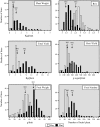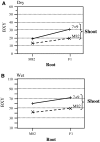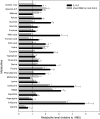Yield quantitative trait loci from wild tomato are predominately expressed by the shoot
- PMID: 20872209
- PMCID: PMC3021191
- DOI: 10.1007/s00122-010-1456-9
Yield quantitative trait loci from wild tomato are predominately expressed by the shoot
Abstract
Plant yield is the integrated outcome of processes taking place above and below ground. To explore genetic, environmental and developmental aspects of fruit yield in tomato, we phenotyped an introgression line (IL) population derived from a cross between the cultivated tomato (Solanum lycopersicum) and a wild species (Solanum pennellii). Both homozygous and heterozygous ILs were grown in irrigated and non-irrigated fields and evaluated for six yield components. Thirteen lines displayed transgressive segregation that increased agronomic yield consistently over 2 years and defined at least 11 independent yield-improving QTL. To determine if these QTL were expressed in the shoots or the roots of the plants, we conducted field trials of reciprocally grafted ILs; out of 13 lines with an effect on yield, 10 QTL were active in the shoot and only IL8-3 showed a consistent root effect. To further examine this unusual case, we evaluated the metabolic profiles of fruits from both the homo- and heterozygous lines for IL8-3 and compared these to those obtained from the fruit of their equivalent genotypes in the root effect population. We observed that several of these metabolic QTL, like the yield QTL, were root determined; however, further studies will be required to delineate the exact mechanism mediating this effect in this specific line. The results presented here suggest that genetic variation for root traits, in comparison to that present in the shoot, represents only a minor component in the determination of tomato fruit yield.
Figures






Similar articles
-
Root-synthesized cytokinins improve shoot growth and fruit yield in salinized tomato (Solanum lycopersicum L.) plants.J Exp Bot. 2011 Jan;62(1):125-40. doi: 10.1093/jxb/erq266. Epub 2010 Oct 19. J Exp Bot. 2011. PMID: 20959628 Free PMC article.
-
Canalization of Tomato Fruit Metabolism.Plant Cell. 2017 Nov;29(11):2753-2765. doi: 10.1105/tpc.17.00367. Epub 2017 Nov 1. Plant Cell. 2017. PMID: 29093214 Free PMC article.
-
Linkage relationships among multiple QTL for horticultural traits and late blight (P. infestans) resistance on chromosome 5 introgressed from wild tomato Solanum habrochaites.G3 (Bethesda). 2013 Dec 9;3(12):2131-46. doi: 10.1534/g3.113.007195. G3 (Bethesda). 2013. PMID: 24122052 Free PMC article.
-
The genetic basis of fruit morphology in horticultural crops: lessons from tomato and melon.J Exp Bot. 2014 Aug;65(16):4625-37. doi: 10.1093/jxb/eru017. Epub 2014 Feb 11. J Exp Bot. 2014. PMID: 24520021 Review.
-
An integrated view of quantitative trait variation using tomato interspecific introgression lines.Curr Opin Genet Dev. 2007 Dec;17(6):545-52. doi: 10.1016/j.gde.2007.07.007. Epub 2007 Aug 27. Curr Opin Genet Dev. 2007. PMID: 17723293 Review.
Cited by
-
Association mapping reveals the genetic architecture of tomato response to water deficit: focus on major fruit quality traits.J Exp Bot. 2016 Dec;67(22):6413-6430. doi: 10.1093/jxb/erw411. J Exp Bot. 2016. PMID: 27856709 Free PMC article.
-
Uncovering tomato quantitative trait loci and candidate genes for fruit cuticular lipid composition using the Solanum pennellii introgression line population.J Exp Bot. 2017 May 17;68(11):2703-2716. doi: 10.1093/jxb/erx134. J Exp Bot. 2017. PMID: 28475776 Free PMC article.
-
The effect of circular soil biosolarization treatment on the physiology, metabolomics, and microbiome of tomato plants under certain abiotic stresses.Front Plant Sci. 2022 Nov 8;13:1009956. doi: 10.3389/fpls.2022.1009956. eCollection 2022. Front Plant Sci. 2022. PMID: 36426148 Free PMC article.
-
The genome of the stress-tolerant wild tomato species Solanum pennellii.Nat Genet. 2014 Sep;46(9):1034-8. doi: 10.1038/ng.3046. Epub 2014 Jul 27. Nat Genet. 2014. PMID: 25064008 Free PMC article.
-
Os11Gsk gene from a wild rice, Oryza rufipogon improves yield in rice.Funct Integr Genomics. 2012 Jun;12(2):277-89. doi: 10.1007/s10142-012-0265-4. Epub 2012 Feb 25. Funct Integr Genomics. 2012. PMID: 22367483
References
Publication types
MeSH terms
LinkOut - more resources
Full Text Sources

